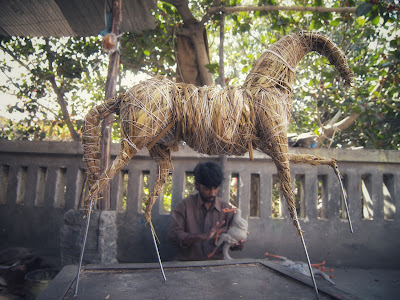A hundred horses, each one with its forelegs in the air, are sunning on the terrace of Anil’s house. They are well-muscled steeds, and Anil’s year-old son totters towards them gleefully, but he is picked up halfway to them and the danger passes.
The sun is shining brightly after three wet winter days and all hands are busy making up for lost time. Pulp casts of elephants and camels are hanging from the tin shed. A boy is twisting wire into frames for making tigers, another is pressing a mould with paper pulp inside, a woman is pasting leather on to the dried and touched-up casts, and I am witnessing the birth of Indore’s lifelike soft toys.
When the toys are finished, they will be packed and shipped to the metros, and even to Australia and the US. Although a traditional craft, they are not much in demand within Indore city, and are mostly sold at a few shops around the old palace, Rajwada. However, Mhow, just 23km away on NH-3, is a big market with its cosmopolitan mix of servicemen and their families from all over the country.
Toy making is an old craft in Indore, but it changed in one important way a few decades ago. While traditionally the stuffed toys were covered with velvet, the city’s craftsmen now use sheep or goat leather as it imparts a lifelike quality to the animal figures. “The muscle tone shines through leather,” says Anil. It is skin, after all, but why not use the more common buffalo hide?
Anil says three qualities make sheep and goat skins ideal for this work: “They are thinner than other hides, and take the shape of the cast that they are stuck upon.” Secondly, he says, “They absorb colour very nicely, which is essential to make the animals look lifelike.” Finally, though they are expensive, their supply is abundant.
Leather is the only raw material that comes from outside Indore. While it is supplied from Hyderabad, the paper pulp comes from Malwa Mills nearby. In fact, the area around this mill has most of Indore’s 20-odd soft toy factories. The remainder operate from Scheme Number 78, Nehru Nagar and Marimata Crossing. As for the little things like eyes and hooves of animals, these are available in the old markets around Rajwada.
With the raw material in place, how are all those beautiful animal figures crafted? The process seems simple enough, with not a single machine being used. But it requires a high degree of skill, which the craftsmen acquire with years of practice. Be it a horse, tiger, camel, elephant or any other animal, they all start out as a wire frame twisted deftly inside a minute. The same hands then bind straw over this frame to create a rough form upon which paper pulp is moulded.
The first workman completes his job within five minutes, and then another presses paper pulp onto this ‘skeleton’ with a mould. Since the pulp is wet and tender, the figure is left out in the open to dry, for a day. The next day, before the pulp hardens completely, an artist touches up the cast animal by defining its muscles and checks for any serious flaws that might result in rejection later on. All this takes just 15 minutes, and after some more drying the piece is ready to get its skin.
The glue used to stick the skin on to the cast is also special. It is made from tamarind seeds, by first roasting, then powdering them, and finally boiling the powder. Sticking the skin onto the cast requires a lot of skill as several small pieces of leather are stuck and yet the final skin has to appear seamless. The pasting is finished within 20 minutes, and then the pieces are set out to dry in the sun again, for a day
The basic toy is now ready, but to be saleable it needs vital finishing touches, like painting and embellishment. This job is done not in the factories but in the homes of the workmen. Each toy takes a few minutes to finish, but the pieces are returned only after a day, when they are a sight to behold. Especially the horses, which return not only richly painted but also equipped with tiny saddles and reins.
















